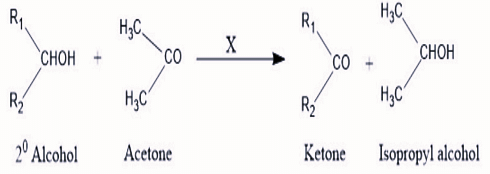Identify A, B and C in below reaction:


- A=Br2, B=KOH, C=NaNH2
- A-Br2, B=HCl, C-NaNH2
- A=Br2, B=HCl, C=NaNH4
- A=Br2, B=KOH, C=NaNH2
The Correct Option is D
Solution and Explanation
To identify A, B, and C in the given reaction sequence, let's analyze each step:
Reaction with A: The initial compound contains an alkene group. When alkenes react with bromine \((\text{Br}_2)\), an anti-addition reaction occurs, leading to vicinal dibromides. Hence, A = Br2.
Reaction with B: The dibromide undergoes dehydrohalogenation. With alcoholic KOH, elimination occurs, forming an alkyne. Therefore, B = KOH.
Reaction with C: The alkyne can undergo further deprotonation when reacted with sodium amide \((\text{NaNH}_2)\) to form a more reactive acetylide ion. Thus, C = NaNH2.
Therefore, the correct sequence is: A=Br2, B=KOH, C=NaNH2.
Top Questions on carbonyl compounds
- Which of the following are neutral?
- KEAM - 2025
- Chemistry
- carbonyl compounds
- Acetone can be converted to 2-methylpropan-2-ol using:
- KEAM - 2025
- Chemistry
- carbonyl compounds
- The correct stability order of carbocations is
- JEE Main - 2024
- Chemistry
- carbonyl compounds
- According to Oppenauer Oxidation reaction, oxidation of secondary alcohol to ketone by reagent (X) in acetone takes place, what is "X" :

- GPAT - 2024
- Organic Chemistry
- carbonyl compounds
- The Gattermann-Koch reaction is used in the industrial preparation of benzaldehyde. The electrophile involved in this reaction is
- CUET (UG) - 2024
- Chemistry
- carbonyl compounds
Questions Asked in GPAT exam
- Which of the following alkaloids are found as salts of meconic acid?
- GPAT - 2025
- Introductory Pharmacognosy
Choose the correct match of laxative and its Mechanism of Action (MOA):

- GPAT - 2025
- Laxative
Match the following:
(P) Schedule H
(Q) Schedule G
(R) Schedule P
(S) Schedule F2
Descriptions:
(I) Life period of drugs
(II) Drugs used under RMP
(III) List of Prescription Drugs
(IV) Standards for surgical dressing
- GPAT - 2025
- Drug therapy
- Which of the following is used to evaluate disinfectant?
- GPAT - 2025
- Pathogens
Match the following:
(P) Tuberculosis (1) Bacterial
(Q) Diphtheria (2) Viral
(R) Yellow fever (3) Toxoids
(S) Malaria (4) Protozoal- GPAT - 2025
- Pathogens